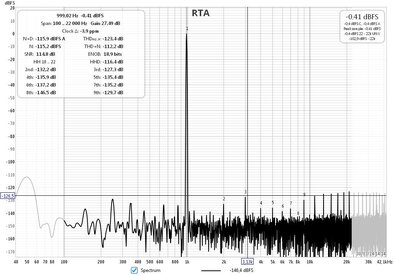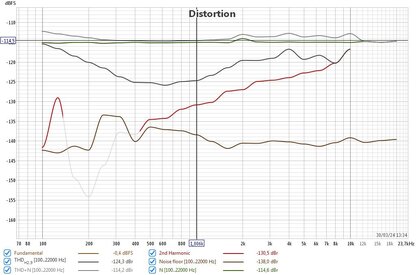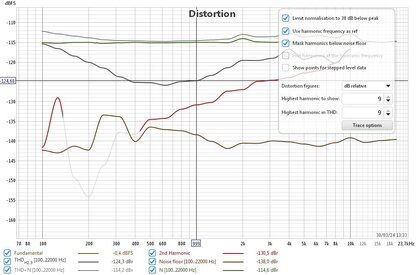Tranzorb
Registered
Thread Starter
- Joined
- Dec 21, 2018
- Posts
- 4
More
- Main Amp
- DIY
- DAC
- Topping D70
- Other Equipment
- Cosmos E1DA ADC
Hello John,
First of all thank you for making REW and all that it makes possible.
I am currently using REW for distortion measurements of a DIY 100W power amplifier, with the usual idea to make it as quiet and distortion less as possible. Currently I am measuring around 0.00015% distortion @50W, up to 10Khz, with around 27uV noise (over 22kHz bandwidth, ie 170nV/sqrt(Hz)), at a gain of 27dB.
For the matter I am using the RTA window, and Stepped sine.
I am currently facing a kind of a dead end issue, because if I understand well the stepped sine measurement calculate the THD on a maximum of ten harmonics.
On the other hand, the RTA THD is calculated up to 50 harmonics, which is fair for the purpose of an amplifer measurement.
However, those measurements are not totally correct depending on the bandwidth we want to measure.
PLS correct me if I misunderstood of course.
Example :
Measurement with HP filter set @22kHz, fundamental 500Hz :
There is also another difference that I noticed, between RTA and Stepped Sine :
Stepped sine makes it mandatory to use at least 2 averages. Howerver, it seems that this averaging is not accounted for for noise calculation. The result is a lower noise figure in stepped sine than what should be, and it is made clearly visible when comparing with RTA (if my understanding is correct once again).
So, to make a long story short, it would be great if :
Thank you very much for taking the time to read this and excuse my english which is not my native language, I hope it was understandable enough.
Best regards,
Frederic
First of all thank you for making REW and all that it makes possible.
I am currently using REW for distortion measurements of a DIY 100W power amplifier, with the usual idea to make it as quiet and distortion less as possible. Currently I am measuring around 0.00015% distortion @50W, up to 10Khz, with around 27uV noise (over 22kHz bandwidth, ie 170nV/sqrt(Hz)), at a gain of 27dB.
For the matter I am using the RTA window, and Stepped sine.
I am currently facing a kind of a dead end issue, because if I understand well the stepped sine measurement calculate the THD on a maximum of ten harmonics.
On the other hand, the RTA THD is calculated up to 50 harmonics, which is fair for the purpose of an amplifer measurement.
However, those measurements are not totally correct depending on the bandwidth we want to measure.
PLS correct me if I misunderstood of course.
Example :
Measurement with HP filter set @22kHz, fundamental 500Hz :
- Stepped Sine : THD will be calculated up to 5kHz (9 harmonics), so the 17kHz above (to reach 22kHz) are not included in the calculation, and the result is much lower than the true one.
- RTA : THD will be calculated up to 25kHz (50 harmonics), and limited to the bandwidth 22kHz (which is exactly what we want). So the result is correct there.
There is also another difference that I noticed, between RTA and Stepped Sine :
Stepped sine makes it mandatory to use at least 2 averages. Howerver, it seems that this averaging is not accounted for for noise calculation. The result is a lower noise figure in stepped sine than what should be, and it is made clearly visible when comparing with RTA (if my understanding is correct once again).
So, to make a long story short, it would be great if :
- THD calculation in Stepped sine could be made over the selected bandwidth, or if it is too tricky calculate it for 50 harmonics, limited to bandwidth (as in RTA).
- Noise calculation in Stepped sine was corrected, maybe only allowing no averaging would do.
Thank you very much for taking the time to read this and excuse my english which is not my native language, I hope it was understandable enough.
Best regards,
Frederic

















